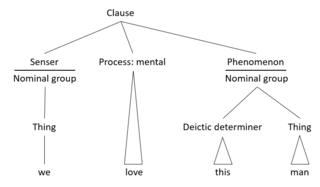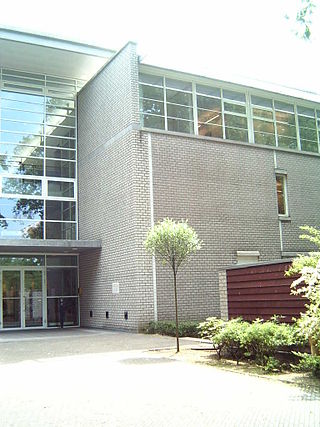Related Research Articles

Functional linguistics is an approach to the study of language characterized by taking systematically into account the speaker's and the hearer's side, and the communicative needs of the speaker and of the given language community. Linguistic functionalism spawned in the 1920s to 1930s from Ferdinand de Saussure's systematic structuralist approach to language (1916).
Transcription in the linguistic sense is the systematic representation of spoken language in written form. The source can either be utterances or preexisting text in another writing system.

Conversation analysis (CA) is an approach to the study of social interaction that empirically investigates the mechanisms by which humans achieve mutual understanding. It focuses on both verbal and non-verbal conduct, especially in situations of everyday life. CA originated as a sociological method, but has since spread to other fields. CA began with a focus on casual conversation, but its methods were subsequently adapted to embrace more task- and institution-centered interactions, such as those occurring in doctors' offices, courts, law enforcement, helplines, educational settings, and the mass media, and focus on multimodal and nonverbal activity in interaction, including gaze, body movement and gesture. As a consequence, the term conversation analysis has become something of a misnomer, but it has continued as a term for a distinctive and successful approach to the analysis of interactions. CA and ethnomethodology are sometimes considered one field and referred to as EMCA.
Harvey Sacks was an American sociologist influenced by the ethnomethodology tradition. He pioneered extremely detailed studies of the way people use language in everyday life. Despite his early death in a car crash and the fact that he did not publish widely, he founded the discipline of conversation analysis. His work has had significant influence on fields such as linguistics, discourse analysis, and discursive psychology.

Discourse analysis (DA), or discourse studies, is an approach to the analysis of written, spoken, or sign language, including any significant semiotic event.
Principles and parameters is a framework within generative linguistics in which the syntax of a natural language is described in accordance with general principles and specific parameters that for particular languages are either turned on or off. For example, the position of heads in phrases is determined by a parameter. Whether a language is head-initial or head-final is regarded as a parameter which is either on or off for particular languages. Principles and parameters was largely formulated by the linguists Noam Chomsky and Howard Lasnik. Many linguists have worked within this framework, and for a period of time it was considered the dominant form of mainstream generative linguistics.
Jenny L. Cheshire is a British sociolinguist and emeritus professor of linguistics at Queen Mary University of London. Her research interests include language variation and change, language contact and dialect convergence, and language in education, with a focus on conversational narratives and spoken English. She is most known for her work on grammatical variation, especially syntax and discourse structures, in adolescent speech and on Multicultural London English.
Kiezdeutsch is a variety of German spoken primarily by youth in urban spaces in which a high percentage of the population is multilingual and has an immigration background. Since the 1990s, Kiezdeutsch has come into the public eye as a multiethnic language.

The Max Planck Institute for Psycholinguistics is a research institute situated on the campus of Radboud University Nijmegen located in Nijmegen, Gelderland, the Netherlands. The institute was founded in 1980 by Pim Levelt, and is unique for being entirely dedicated to psycholinguistics, and is also one of the few institutes of the Max Planck Society to be located outside Germany. The Nijmegen-based institute currently occupies 2nd position in the Ranking Web of World Research Centers among all Max Planck institutes. It currently employs about 235 people.
Sandra Annear Thompson is an American linguist specializing in discourse analysis, typology, and interactional linguistics. She is Professor Emerita of Linguistics at the University of California, Santa Barbara (UCSB). She has published numerous books, her research has appeared in many linguistics journals, and she serves on the editorial board of several prominent linguistics journals.
Interactional sociolinguistics is a subdiscipline of linguistics that uses discourse analysis to study how language users create meaning via social interaction. It is one of the ways in which linguists look at the intersections of human language and human society; other subfields that take this perspective are language planning, minority language studies, quantitative sociolinguistics, and sociohistorical linguistics, among others. Interactional sociolinguistics is a theoretical and methodological framework within the discipline of linguistic anthropology, which combines the methodology of linguistics with the cultural consideration of anthropology in order to understand how the use of language informs social and cultural interaction. Interactional sociolinguistics was founded by linguistic anthropologist John J. Gumperz. Topics that might benefit from an Interactional sociolinguistic analysis include: cross-cultural miscommunication, politeness, and framing.

Neal R. Norrick held the chair of English Linguistics at Saarland University in Saarbrücken, Germany, where he established a linguistics curriculum firmly based in pragmatics and discourse analysis. In the last two decades, he has become an important personality in linguistic pragmatics for his pioneering works on humor and narrative in conversational interaction.
In linguistics, stance is the way in which speakers position themselves in relation to the ongoing interaction, in terms of evaluation, intentionality, epistemology or social relations. When a speaker describes an object in a way that expresses their attitude or relation to the object, the speaker is taking a stance. Stancetaking is viewed as a social action that shares the speaker's view of an object with their audience, sometimes inviting listeners to take their own stance as well.
Peter Auer is professor of Germanic Linguistics at the University of Freiburg in Freiburg im Breisgau, Germany. Auer graduated from the University of Constance in 1983. He worked at the University of Hamburg before going to Freiburg.
Deborah Sue Schiffrin was an American linguist who researched areas of discourse analysis and sociolinguistics, producing seminal work on the topic of English discourse markers.
In linguistics, a co-construction is a single syntactic entity in conversation and discourse that is uttered by two or more speakers. Other names for this concept include collaboratively built sentences, sentences-in-progress, and joint utterance constructions. Used in this specific linguistic context, co-construction is not to be confused with the broader social interactional sense of the same name. Co-construction is studied across several linguistic sub-disciplines, including applied linguistics, conversation analysis, linguistic anthropology, and language acquisition.
Charles Goodwin was a UCLA distinguished research professor of communication and key member of UCLA’s Center for Language, Interaction and Culture. Goodwin contributed ground-breaking theory and research on social interaction and opened new pathways for research on eye gaze, storytelling, turn-taking and action.
Suzanne Eggins is an Australian linguist who is an Honorary Fellow at Australian National University (ANU), associated with the ANU Institute for Communication in Health Care. Eggins is the author of a best selling introduction to systemic functional linguistics and she is known for her extensive work on critical linguistic analysis of spontaneous interactions in informal and institutional healthcare settings.
Theory of language is a topic in philosophy of language and theoretical linguistics. It has the goal of answering the questions "What is language?"; "Why do languages have the properties they do?"; or "What is the origin of language?". In addition to these fundamental questions, the theory of language also seeks to understand how language is acquired and used by individuals and communities. This involves investigating the cognitive and neural processes involved in language processing and production, as well as the social and cultural factors that shape linguistic behavior.
Elizabeth Couper-Kuhlen is an American linguist and distinguished professor (emeritus) from the University of Helsinki.
References
- 1 2 Laury, Ritva; Etelämäki, Marja; Couper-Kuhlen, Elizabeth (2014). "Approaches to grammar for interactional linguistics". Pragmatics. Quarterly Publication of the International Pragmatics Association. 24 (3). John Benjamins: 435–452. doi:10.1075/prag.24.3. ISSN 1018-2101.
- 1 2 Barth-Weingarten, Dagmar (2008). "Interactional Linguistics". Handbook of Interpersonal Communication. Handbook of Applied Linguistics. Vol. 2. Mouton de Gruyter. pp. 77–106. doi:10.1515/9783110211399.1.77. ISBN 9783110211399.
- 1 2 Couper-Kuhlen, Elizabeth; Selting, Margret (2018). Interactional Linguistics: Studying Language in Social Interaction. Cambridge: Cambridge University Press. doi:10.1017/9781139507318. ISBN 9781107032804.
- ↑ Femø, Mie Nielsen; Steensig, Jakob; Wagner, Johannes (2 April 2006). "Konversationsanalyse i Danmark". Studies in Modern Danish (in Danish) (34–35): 182–216. doi:10.7146/NYS.V34I34-35.13461. ISSN 2246-4522. Wikidata Q109745891.
- ↑ "Notices". Linguistics. 38 (1). Walter de Gruyter: 219. 2000. doi:10.1515/ling.38.1.219. ISSN 0024-3949.
- 1 2 Couper-Kuhlen, Elizabeth; Selting, Margaret (2001). Studies in Interactional Linguistics. John Benjamins. doi:10.1075/sidag.10. ISBN 9789027297310.
- ↑ Hopper, Paul (1988). "Emergent Grammar and the A Priori Grammar Postulate". In Deborah Tannen (ed.). Linguistics in Context.
- 1 2 Su, Danjie (2016). "Grammar emerges through reuse and modification of prior utterances". Discourse Studies. 18 (3): 330–353. doi:10.1177/1461445616634551. S2CID 57406296.
- ↑ Hornstein, Norbert; Nunes, Jairo; Grohmann, Kleanthes K. (2005). Understanding Minimalism. New York: Cambridge University Press.
- ↑ Fox, Barbara (2007). "Principles shaping grammatical practices: an exploration". Discourse Studies. 9 (3): 299–318. doi:10.1177/1461445607076201. S2CID 220785959.
- ↑ Etelämäki, Marja (2016). "Introduction: Discourse, grammar and intersubjectivity". Nordic Journal of Linguistics. 39 (2): 101–112. doi: 10.1017/S033258651600007X . S2CID 151640262.
- ↑ Jakob Steensig; Maria Jørgensen; Nicholas Mikkelsen; Karita Suomalainen; Søren Sandager Sørensen (3 April 2023). "Toward a Grammar of Danish Talk-in-Interaction: From Action Formation to Grammatical Description". Research on Language and Social Interaction. 56 (2): 116–140. doi:10.1080/08351813.2023.2205304. ISSN 0835-1813. Wikidata Q121071205.
- ↑ Ochs, Elinor; Schegloff, Emanuel; Thompson, Sandra (1996). Interaction and Grammar. Cambridge University Press.
- ↑ Mihas, Elena (2017). Conversational structures of Alto Perené (Arawak) of Peru (PDF). Studies in Language Companion Series. Vol. 181. John Benjamins. doi:10.1075/slcs.181. ISBN 978-90-272-5946-2.
- ↑ Steensig, Jakob; Brøcker, Karen Kiil; Grønkjær, Caroline; Hamann, Magnus; Puggaard, Rasmus; Jørgensen, Maria; Kragelund, Mathias Høyer; Mikkelsen, Nicholas Hedegaard; Mølgaard, Tina; Pedersen, Henriette Folkmann; Sørensen, Søren Sandager; Tholstrup, Emilie (2013), "The DanTIN project: Creating a platform for describing the grammar of Danish talk-in-interaction", in Petersen, Jan Heegård; Henrichsen, Peter Juel (eds.), New Perspectives on Speech in Action: Proceedings of the 2nd SJUSK Conference on Contemporary Speech Habits, Frederiksberg: Samfundslitteratur Press, pp. 195–227
- 1 2 Pia Bergmann; Jana Brenning; Martin Pfeiffer; Elisabeth Reber (2013), Towards an Interactional Grammar, De Gruyter, pp. 1–16, doi:10.1515/9783110295108.1, Wikidata Q117303510
- ↑ Wolfgang Imo (2015). "Interactional Construction Grammar". Linguistics Vanguard . 1 (1): 69–77. doi:10.1515/LINGVAN-2015-0008. ISSN 2199-174X. Wikidata Q117304006.